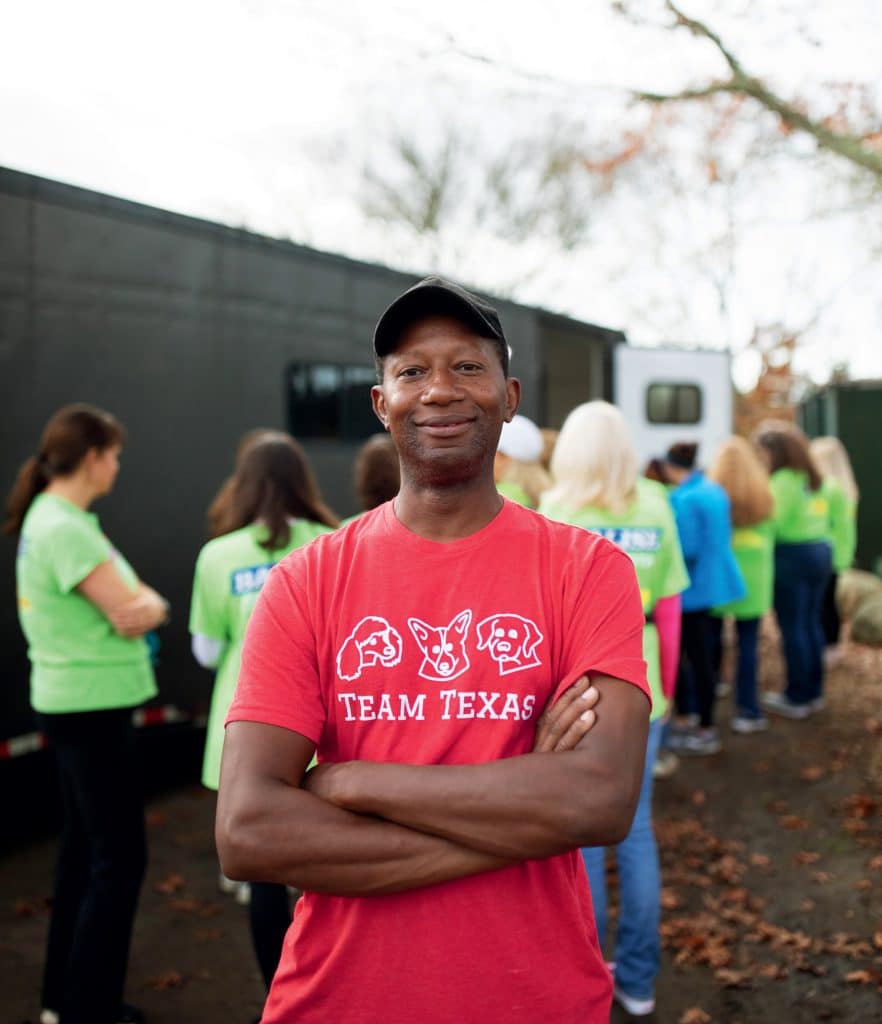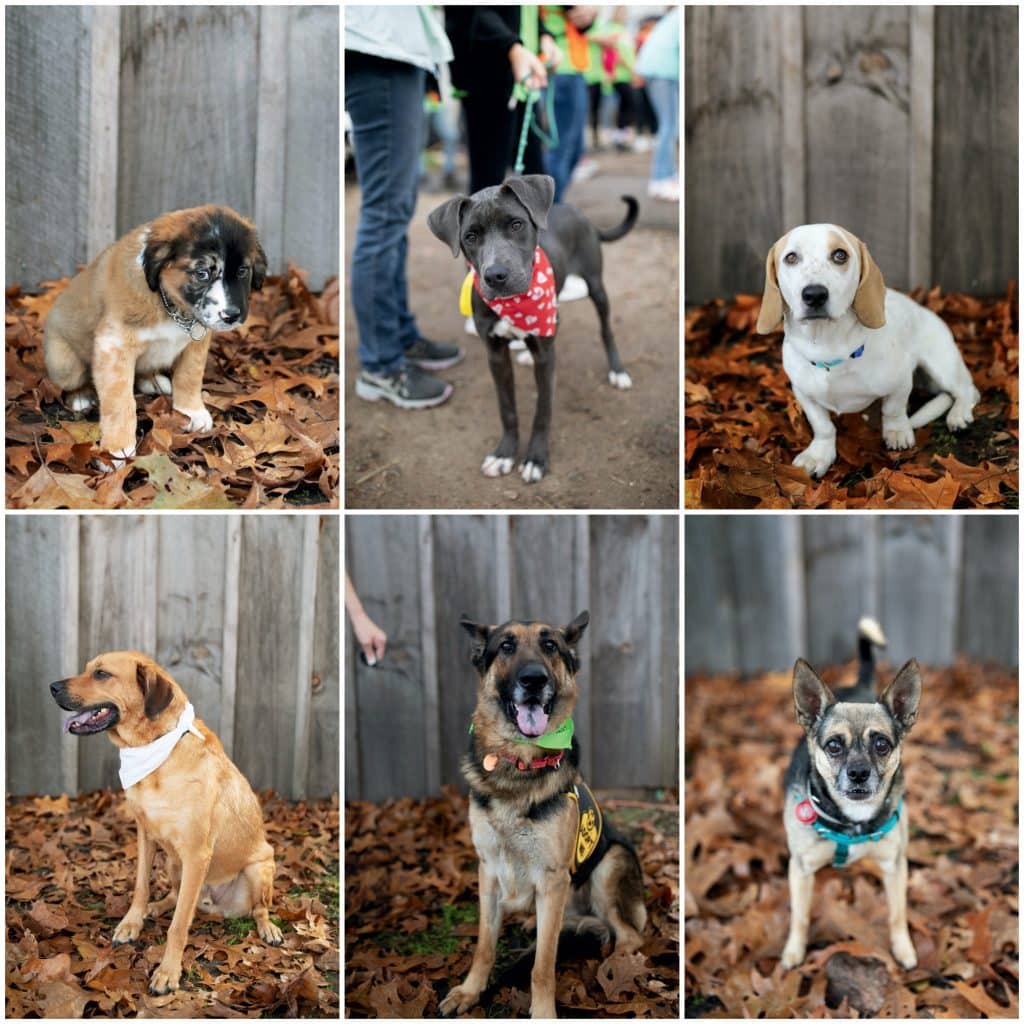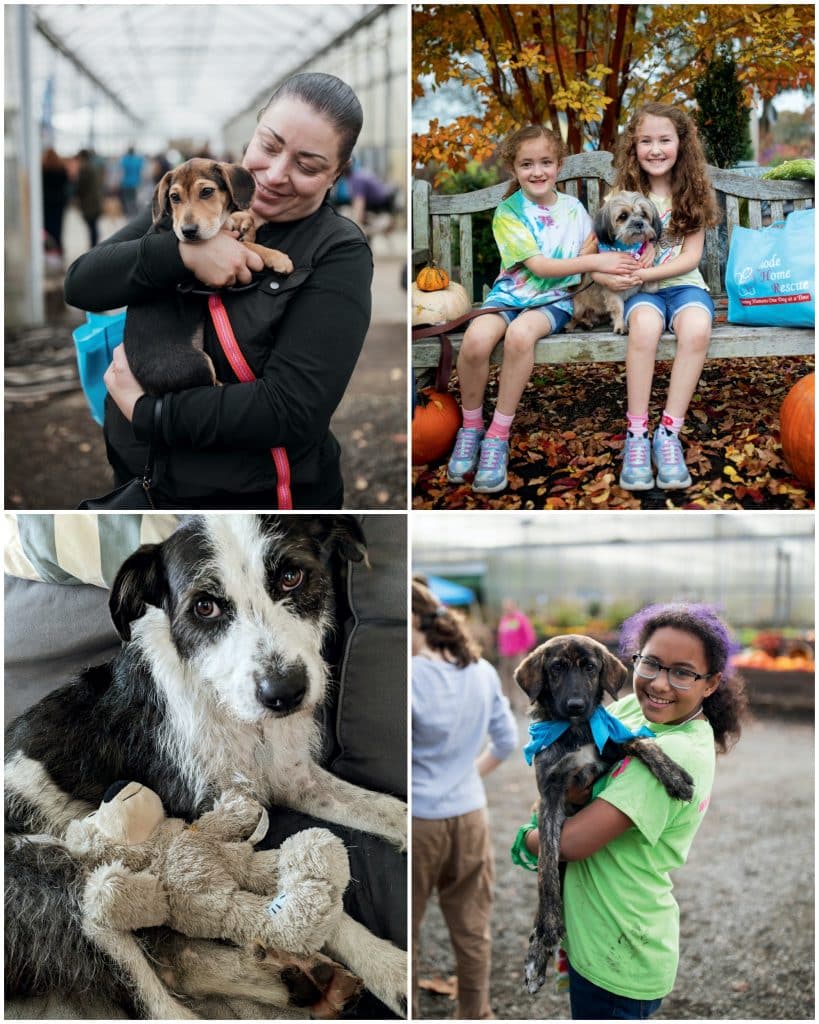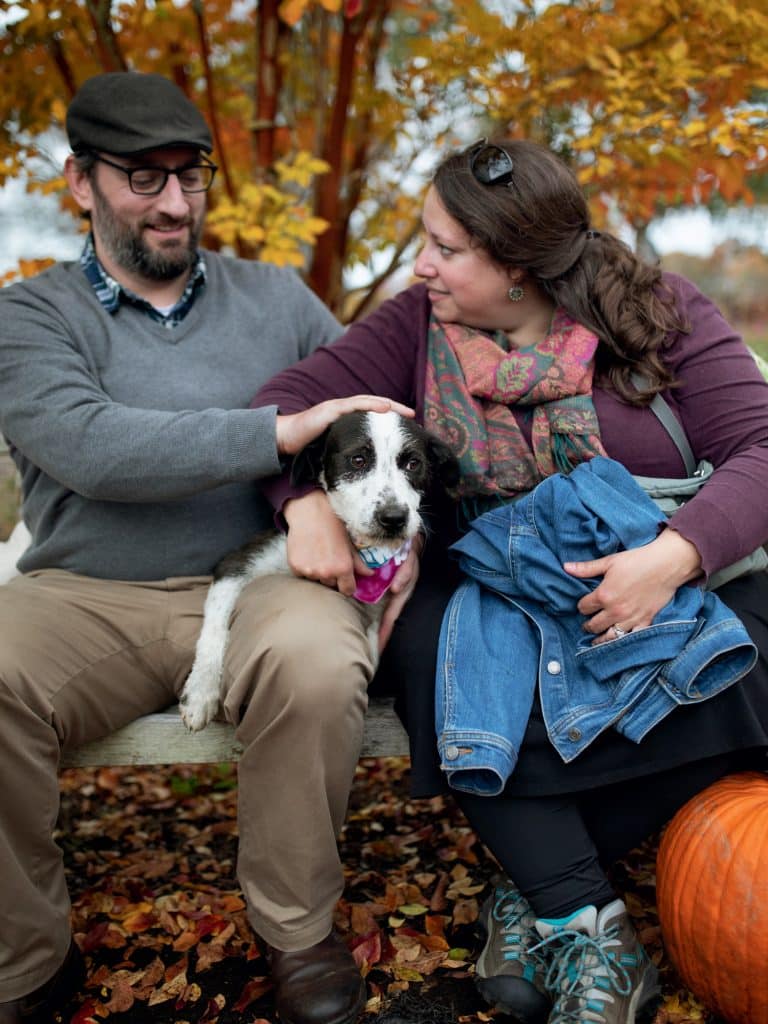Always Adopt: Rhode Island’s Twice-Yearly Supersize Dog Adoption Event
For thousands of rescued dogs, journeys of endless miles and hardship come to a happy end with the help of Rhode Island’s Always Adopt, one of the biggest dog adoption events in the country.

Coffee By Design | Portland, Maine
Photo Credit : Katherine KeenanOne day early last fall, a passerby found a young stray huddled on a road with three of her puppies. This was in Beaumont, Texas, 85 miles east of Houston, and—like many places in the South, where far fewer pets are spayed or neutered compared with the rest of the nation—the population of homeless dogs and cats overwhelms the city’s ability to care for them. Each day thousands of dogs lose their lives in the so-called “kill shelters” of the South, even though those who work there may wish they had other options. When a stray or owner-surrendered animal lands in an overcrowded shelter, their life-span rarely exceeds a week. More animals will soon arrive to take their place.
The good Samaritan who found the mother and her pups knew whom to call: Carlos Davis and his Animal Rescue Kingdom (A.R.K.), located west of Houston. Davis is a soft-spoken, lean man of 49 whose life revolves around finding homes for as many dogs as he can. He lives on a 10-acre rural ranch, where 60 to 70 dogs at a time can rest and heal while awaiting a journey to a new life. On Saturday and Sunday mornings for nearly the past two decades, Davis has brought his dogs to a local vet for medical care and spaying or neutering. When it comes to weekends, he says, “I don’t go the lake, I don’t hang out with friends—I go to the vet.”

Photo Credit : Maaike Bernstrom
Each year he transports more than 1,300 rescued dogs to the Northwest and New England, driving thousands of miles to give them a chance at a new life. He compares what he does to “trying to empty the sea with a spoon,” and then admits, “Sometimes I just cry. The hardest part is that for every dog I save, I know I leave so many others behind.” He says he has no choice but to try. “These dogs deserve so much more. They show us so much love when they are with us. That’s why I dedicate my life to them.”
As soon as the Beaumont call came in, Davis fetched the mother and puppies. When he examined them back at the ranch, they were—like nearly all the animals he takes in—beset by parasites and worms, flea-ravaged, undernourished. He named the mother “Annie.” She was small, black and white, with rough fur that suggested wirehaired terrier ancestry. She was playful and filled with the good nature of a dog who seemed to know her life had taken a turn. “She was my shadow. She followed me everywhere,” Davis recalls. “She even jumped a four-foot-high fence just to be where I was.”
While some dogs need months to be well enough to travel, Annie’s stay at the ranch would last only a few weeks: time to mend, to be spayed, microchipped, groomed, and well fed. To be made as attractive and appealing as a dog who likely had never slept indoors could be. Then, in the early-morning darkness of Tuesday, November 1, Annie and her puppies found themselves crated in a 28-foot trailer hitched to a steel-gray van. Joining them were some 100 other rescued dogs, all bound for Rhode Island, 1,800 miles and 40 hours away.
At several points along the way, Davis and his two helpers would stop and walk the dogs, letting them sniff the fresh air. “Three hours is as long as I go without seeing what is happening back in the trailer,” Davis explains. By early Thursday they had arrived at a farm not far from the Rhode Island ocean. There, the rescues would recover from the long trip, and be bathed and groomed, nails clipped, ready for their closeup in two days.
On Saturday, Annie, along with her traveling companions, went back into their crates, this time for a short ride to Clark Farms in Matunuck, where an immense greenhouse and property had been given over to Always Adopt, one of the biggest dog adoption events in the country. They would be joined by many other Southern rescues who had been living with local foster families and at New England shelters. For six hours, from 10 a.m. to 4 p.m., Always Adopt would see throngs of people coming by and experiencing something like a rescue street bazaar, filled with barking, tails wagging, and an almost overwhelming mix of excitement and nerves.

Photo Credit : Maaike Bernstrom
The event’s creator and director for the past decade is Louise Anderson. “Imagine how you felt when you adopted your own dog,” she tells people. “Now multiply that feeling by hundreds.”
Inside the greenhouse, the dogs who only weeks earlier faced a bleak future would now have a few hours, as one rescue volunteer said, “to win you over.”
* * * * *
The first Saturday in November brings short-sleeve weather by early morning. The last of Clark Farms’ pumpkins lie on the ground, along with dry corn stalks from its popular maze. Anderson has been here since 6 a.m., but the event itself is the easy part. For the past several months she has been working to ensure that everything comes together for this day: the area shelters that bring their dogs, Davis’s transport, health certifications for all the rescues, references from vets for everyone who had applied online for a dog, pet approvals from landlords for their tenants, even a food truck.
For Anderson, the stakes are too high to relax. “These dogs have come a long way,” she says. “I think they somehow know it’s their chance. We call it their ‘freedom ride.’”
She has organized Always Adopt days twice a year in Rhode Island since 2013, missing only two pandemic years. The event has grown from hosting 90 dogs and welcoming 700 people in the beginning to often having more than 400 dogs and several thousand people. Like many who work in animal rescue, she says success is not about numbers, that one healthy dog killed is too many, but still: Under her watch, more than 7,000 rescues have found a new life.
Shortly before 9 a.m., Anderson speaks to her team of volunteers outside the greenhouse. She is upbeat and energetic, dressed in shorts and sneakers with a pink Always Adopt T-shirt with “Pack Leader” emblazoned on the back. A volunteer handler is assigned to be with each of the nearly 300 dogs. There are also dog trainers and helpers to keep everything clean, water dishes filled, hundreds of cars parked, and all the people checked in.
To understand Anderson’s passion for this day, you need to know her backstory. After 20 years as a physical therapist in Britain, she married an American businessman, John Nicolosi. They moved to Rhode Island in 2001, and in 2006 she shifted her focus to therapy for small animals. “No rescue animal ever pays for PT [from me],” she notes. “Some special-needs animals get free treatment for life.”
Every dog she has ever owned has been her “soul mate,” Anderson says, and years after losing them she still tears up when saying their names. Her current dog is a collie mix named Teddy, found in a roadside box in Tennessee beside a sign reading “Free puppies.” She and her husband set up the Nicolosi Foundation for Animal Welfare to pay the bills for Always Adopt and to help other rescues with medical care for their animals. (The $600 adoption fee at the event covers only a fraction of what rescue shelters and foster families actually pay to care for the animals, often for weeks at a time.)
Anderson’s life changed after she watched a documentary in 2012 about kill shelters. “I couldn’t sleep for days,” she remembers. “I thought, What can I do? What can one person do? Not a lot? Or can I?” She attended conferences on dog adoption and visited shelters to learn about their challenges. “When I first started doing this,” she says, “the only way people were adopting [kill-shelter] dogs was on wonderful websites like Petfinder and Adopt a Pet. You’d click on the site and look at photos and fill out an application, and soon the dog would be put on a transport and you might meet your new friend at a truck stop. Boom—into your arms. I thought it was amazing how well it works. The dogs leap out, and it’s like they know this is their family now. But I thought, What if we could bring a lot of dogs who needed homes to one place on one day? People could see so many at once. They could look into a dog’s eyes. We could be matchmakers.”

Photo Credit : Maaike Bernstrom
And then she decided this: “I had to go to the front lines. I had to visit my rescue partners down South. I had to experience what they did. What they felt.” So she accompanied rescue workers to a Louisiana kill shelter as they chose the dogs they could save on one day. With them, she also searched under bridges for strays, listening for little voices and whimpers. “I needed in some small way to understand what they have to do. Their daily routine is looking for abandoned animals. They are the real heroes here. They will keep [the dogs] for as long as they need to, to get them healthy to find homes.” It is why she and Davis have been friends for years: In the animal rescue world, where burnout and discouragement take a steep toll, they live for the victories.
“Advocate for the dog,” she tells the Always Adopt volunteers. “Ask people not to rush. Find out as much as you can about the dog you’re handling, so you can be as informed as possible to anyone showing interest in your dog.” Her voice rises as she wraps up her short talk. “Now let’s find all these dogs a home!”
The greenhouse doors are set to open at 10. As Anderson finishes, a symphony of barking announces the arrival of Davis and his long-distance cargo. One by one, Davis’s dogs are delivered into the hands and leashes of their handlers, and scamper off.
Anderson looks around. “I just want people to come with an open heart,” she says.
* * * * *
Waiting in a long line of preapproved “early birds” to enter right at 10 is a young couple from Providence: Sarah, a librarian, and her husband, Sam, an architect. A year and a half earlier, they’d said good-bye to their miniature schnauzer, Stich. “He was such a good boy,” Sarah says. As Stich aged, he lost his hearing, his eyesight faded, he stumbled. “We kept adapting to whatever changes he needed. We got a dog stroller and propped him up with cushions so he could eat. Then the spark left him. Our vet understood.
“I thought I would never want another dog,” she continues. “How can another dog be as cute? Or make us laugh again? I wasn’t ready. But after a year, my husband started asking, so we visited shelters. Every time a shelter listed a dog that looked promising, it would get swooped up by someone else. I thought Always Adopt would mean more chance at finding the one.”

Photo Credit : Maaike Bernstrom
What Sarah does not know, as she waits to enter, is the answer to what everyone who has lost a dog wonders: Will I be ready?
When the doors open, handlers are walking their dogs on leashes to show them off. The puppies play in their own enclosed area. The participating shelters have set up displays with photos of their dogs and paperwork ready to be filled out. Anderson has given each shelter a bell; when a dog is adopted, that bell’s ring fills the room.
There is a lot to take in—too much for some dogs. In a quiet corner, Gina Macaione crouches over one trembling animal. A certified Reiki master, she says her task is to “chill the little guys out.” She massages calming oil into the dog’s fur, pressing into tense muscles while speaking softly. “I keep them here long enough to get them to not be nervous. I don’t want them to miss out on their forever home.” When Macaione finishes, the handler tells the dog, “You are going home today to a soft bed and a lovely family.” Macaione takes a breath. “Fingers crossed.”
Kelli, a 3-year-old shepherd mix from Texas, enters shaking. But after a few minutes nestled against Macaione, she calms. Dawn, her handler, leads her just beyond the greenhouse, away from the buzz. They sit together beside a little hut with “Letters to Santa” on its door. When people walk past, glancing but not stopping, Dawn calls quietly but with a tone of urgency: “Take a look.”
Outside the greenhouse is a special section with a sign reading “Meet and Greet.” If a potential adopter already has a dog at home, an important test awaits: Will the two animals be compatible? One of Davis’s dogs, Ashley, is here—small, black and brown, with long, thin hair. Her handler, Stephanie, leads her to where a retired nurse named Jacqueline and her husband are waiting with their dog, Archie. “Are you ready to meet your new family?” Stephanie asks.
“Ashley, welcome to New England,” Jacqueline says, as the dogs meet, sniffing, figuring things out. (“No aggression,” notes Stephanie. “That’s a good thing.”) Ashley will live with her new family, with lots of space to romp. “I can have fun with my new kids,” Jacqueline says. “Archie now has a new friend.”
An older man is walking with a dog he’s adopting: Tyson, whom Davis has ferried north. “C’mon, buddy,” the man coaxes. “He needs meat on his bones,” says the handler. The man’s daughter explains that her father, who is 85, lost his dog a while ago and now “needs someone to look after.” She says if anything happens to her father, she and her husband will take Tyson in. “He’s so mellow,” Davis says, leaning down for a good-bye pat. “He has a brother. There wasn’t room for him this time. Next time.”
By midafternoon, the crowd has thinned a bit. Bells have been ringing constantly, and you see cars driving away, windows down, the heads of dogs poking out, sniffing the scent of freedom. A volunteer named Lisa says she has done this for seven years and has always left happy because the dog she was assigned to handle had found a home. But it’s now three hours in, and she’s getting worried about her current charge, a year-old mix of generations of Texas strays. A family with a little blue-eyed girl is headed to where the puppies are playing, but they pause to look at Lisa’s dog. The girl kneels down to provide a friendly pat before they move on.
In the final hour before the end of the event, Anderson walks through the greenhouse, talking quietly with the volunteers. Perhaps two dozen dogs remain, but none will ever return to the South; they belong now to New England. The next day, they will be brought to a nearby PetSmart adoption event, and most will go to new homes that day, with foster families taking care of the few that on this day did not hear their names called.

Photo Credit : Maaike Bernstrom
As for Sarah and Sam, the young couple from Providence, they had come to Always Adopt wanting a male but were stopped by the sight of a small black and white female, with fur that spoke of wirehaired terrier along the way. It was Annie, and amid the swirl, she was quietly wrapped around her handler’s legs. “She was just looking around,” Sarah would later recall. “No barking, no wagging or pulling, and most important, no other interested parties. We just locked eyes.”
“Let’s take a walk,” Sarah told Annie. When she and Sam and the dog sat together outside, there were tears. Looking back on that moment, Sarah says she realized: “I was ready.”
Nearly a year later, Sarah sends this report: “Annie is a cuddler. She loves to dive into your arms and push her head into your neck. She cannot get close enough! We go to dog parks and she loves to steal the ball from a dog that’s playing fetch and then get the entire park pack to chase her. We have said many times how lucky we are to have her.”
The Quest for Forever Homes
- The next Always Adopt event is November 4 at Clark Farms in Matunuck, Rhode Island. For more information, go to alwaysadopt.com.
- To learn more about Carlos Davis and his efforts to bring unwanted dogs to New England, find Animal Rescue Kingdom’s page on Facebook or go to arktexas.org.
- There are hundreds of animal shelters across the country that survive on donations. Contact ones where you live to find out ways you can help.








So glad that people like these people are out there. Makes me think there’s hope for this world yet.